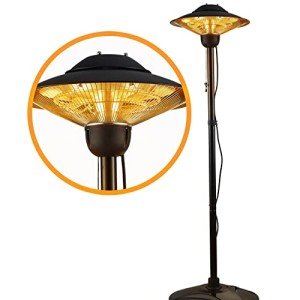How to Choose a Patio Heat Lamp Electric

When you want to heat your patio, you've got several options. Electric heaters are more efficient than propane models, which require fuel refills. They can be heated immediately by pressing a button, or flicking the switch.
They don't release any gases that could be an health risk. Some models have adjustable temperature settings for varying distances.
Type of Heater
You can relax outside throughout the day and throughout the seasons with the proper patio heater. There are many kinds of patio heaters, including freestanding propane and natural gas models as also ceiling- or wall-mounted electric radiant heaters. Your choice will depend on the dimensions of the area, the power sources available, and your personal preferences.
Most patio heaters use electricity, liquid or natural gas to generate heat. They release heat through convection heating in combination with radiant heating. The output of heat from patio heaters is measured in watts, which can be converted into British thermal units (BTUs) to give a comparative. Some models can be adjusted in temperature settings that give you more flexibility.
Patio heat lamps incorporate an electric burner on a pole with a perforated screen that reflects flames and sends heat downwards to warm people, objects and furniture. Some patio heat lamps come with reflective reflectors that sit over the burner, which can be silvered in order to decrease the amount of heat is lost upwards.
Gas patio heaters are the most commonly used patio heaters. They can heat multiple tables quickly and evenly. These patio heaters can be portable and run off a propane tank or plumbed into your natural gas line which is greater convenience and lower initial installation costs but requiring an ongoing cost of fuel.
A growing number of homes are fitted with natural gas lines, making them the ideal option for those who prefer a gas-powered patio heater. These heaters are easy to install, but they require a gas line that's properly installed and operating to ensure safety. Natural gas heaters that are portable come with extension hoses to help overcome this limitation, but they can pose a tripping risk and can create an additional fire hazard when not being used.
electric patio heater outdoor of electric patio heaters are safe to use in enclosed areas due to their ability for heat to radiate outward instead of upward toward combustible materials like the roof. They are not intended to be used on an unprotected roof. The heater should be placed at a minimum of 6" away from the ceiling, or 18" away from the wall in order to prevent fire hazards.
Patio heaters made of propane and gas are typically safe to be installed in enclosed areas with the proper cover designed for open-air use. These covers are usually made of fire-retardant canvas and have the option of having a roof that is closed. These types of patio heaters have security concerns due to the fumes and flames they produce. They should be kept away from objects that ignite, such as curtains and chairs.
Follow the guidelines and safety guidelines of the manufacturer when installing a patio heater or heat lamp. Make sure you select one that has UL and CSA certifications. Also, read the owner's manual thoroughly. Be sure that the heater is out of reach of children and pets. Some patio heaters that are freestanding like EUROM have a built-in tipping protection that automatically shuts off the device in the event that it falls over.
If your patio heater is connected to a natural-gas line, it is recommended to check its condition periodically and test it by a licensed professional to identify leaks. If the line needs to be replaced, hire a licensed plumbing professional. A professional will be able to determine if the line has been properly routed or should be run through an underground pipe. In addition, a professional can make sure the patio heater is plugged into an outlet that's GFCI (ground fault circuit interrupter) certified to guard against electrical shocks and fires.
Installation
The the height at which a patio heater is positioned determines the amount of heat it will radiate into the area. The heater should be mounted away from surfaces such as plastic and wood that may deform. Depending on the model of heater you may choose to mount it on a wall or a structure using conventional mounting brackets. Some models have a soft start feature, which lowers the current peak in order to protect your circuits.
